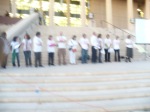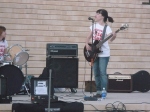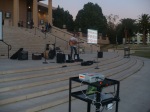I anchored and produced this particular newscast. A lot of work, but nonetheless, a huge accomplishment.
-By Medhanie Habte
11/13/2008 01:14am
It was to be a day of prayer, hope and protest at the campus
of Cal State Northridge, but with good news coming a few days before, a cautious sigh of relief was the order.
Nevertheless, chants from students and faculty, and shirts
with the words “Free Esha” bellowed in front of the university’s Oviatt
Library.
“A lot has been said about Esha’s virtues and her great
qualities which we all know that’s why we love her and everybody’s proud of
her,” said CSUN Professor David Blumenkrantz. “It’s safe to say that if Esha
were here tonight, we would not be here.”
An ample group of students, faculty and friends gathered in
front of the library Tuesday as the sun set to celebrate and pray for the
release of CSUN graduate student Esha Momeni.
Momeni, 28, was released on bail from Teheran’s Evin prison
25 days after being arrested during a traffic stop. She had been working on a
master’s thesis about the women’s political movement in that country. Born in
the United States,she has dual citizenship in both nations.
Little is known about the conditions Momeni endured in one
of the world’s notorious prisons, but her colleagues said they are relieved and
hopeful for her to return to the States.
“She’s been released on bail but we want to call for her
release and return to Los Angeles,” said graduate student Anasa Sinegal. “It is a celebration, because we’re veryhappy she’s out, but we want her to return to the United States.”
Esha was working on a thesis on the women’s rights movement “One
Million Signatures,” a campaign dedicated to promoting social justice and
equality to women in the dominantly Islamic nation. During the arrest
photographs, film and a computer were seized by Iranian police.
Nayereh Tohidi, a professor of gender and women’s studies at
CSUN, reflected on the campaign and referred to journalist and movement founder Parvin Ardalan who was to have received the Olof Palme award in 2007 for her work, only to have been arrested.
“So I appreciate as another Iranian-American, the college and all the support this has been receiving because of all the solidarity we
have,” said Tohidi.
Faculty, student and staff gathered to listen to a concert by bands Fort King and Karabal Nightlife, and a spoken word session.
“She has shown in trying to deliver a simple message and that is that Iranian women are much more complex and a whole lot tougher than the typical media images of them that we usually see,” CSUN Professor Melissa
Wall told gatherers.
Professors, colleagues and friends later stood at the steps
of the Oviatt library to share their stories of Esha and hope of her safe
return home. As the sun set and darkness loomed, those who gathered, lit
up their candles and chanted “Free Esha.”
Students have described Esha as one of a kind, a student who
has taught people more about the world than imagined. Some have described her as a non-violent revolutionary, believing in a better place for all.
“It’s a great thing that she was released,” said CSUN journalism major Krystina Gillenwater “I’m very proud of her work and am glad to see her free. It’s nice to see the student’s here showing their support.”






